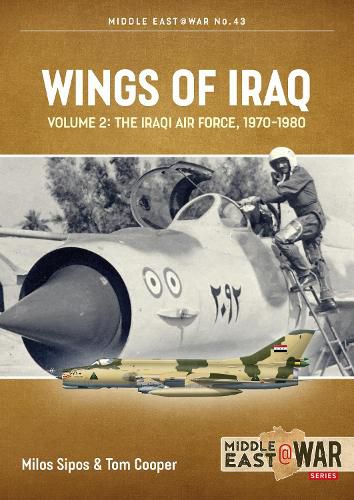Wings of Iraq Volume 2: The Iraqi Air Force, 1970-2003
Tom Cooper,Milos Sipos

Wings of Iraq Volume 2: The Iraqi Air Force, 1970-2003
Tom Cooper,Milos Sipos
Officially established on 22 April 1931, around a core of 5 pilots and 32 aircraft mechanics, the Royal Iraqi Air Force was the first military flying service in any Arab country. Coming into being with the task of supporting the Iraqi armed forces and the British against revolts by local tribes, it saw extensive combat and gradually grew into a potent force. During the Anglo-Iraqi War of 1941, it became involved in its first conventional campaign in support of an anti-British coup but was destroyed as a fighting force. It was still recovering when deployed in combat again, this time against Israel in the course of the Palestine War of 1948-1949. During the relatively quiet decade of the 1950s, the air force experienced a rapid growth, further intensified once the monarchy was toppled during the 14 Tammuz Revolution in 1958, and once again, after two additional coups in 1963. During all of these affairs, a dozen additional coup attempts in the 1960s, and then during the long and bitter war against a Kurdish insurgency in the north, and the next clash with Israel in 1967, the Iraqi Air Force continued playing a dominant role in the fate of the country. The situation changed only little following the coup of 1968 that brought the Ba'ath Party to power. What did instrument a major change was the air force’s involvement in the October 1973 Arab-Israeli War, and then the showdown with the Iranian-supported Kurdish insurgency in northern Iraq in 1974-1975. These two affairs taught the Iraqis that numbers alone did not make an air force. Correspondingly, during the second half of the 1970s, Baghdad embarked on a project based on full technology transfer from France, which was intended to result in preparing the IrAF for the 21st century. This process hardly began when the new ruler in Baghdad, Saddam Hussein at-Tikriti, led his country into an invasion of neighbouring Iran, embroiling it in a ruinous, eight-year-long war. Amazingly enough, for the first few years of that conflict, the IrAF still continued planning and growing as if there was no conflict to fight, although frequently suffering heavy losses while
due to the micromanagement from the government
de-facto fighting with one hand tied to its backs. It was only the experience of facing sustained and massive Iranian offensives of the 1984-1986 period that prompted Baghdad into unleashing the air force into an all-out campaign against the Iranian economy that effected a turn-around in the war. Almost unexpectedly, the IrAF emerged from the eight years of Iran stronger, better equipped and better trained, and more experienced than ever before. However, Saddam Hussein took care to remove all of its top commanders, and replace them with his favorites, thus de-facto castrating the most powerful branch of the Iraqi armed forces shortly before embarking upon his ultimate adventure: the invasion of Kuwait in 1990. The resulting Second Persian Gulf War of 1991 left the IrAF in tatters: mauled by sustained air strikes on its air bases, and cut off from its former sources of equipment and training, it was never to recover again, and rather vegetated for the last years of existence, pending its ultimate destruction during the US-led invasion of 2003. Although virtually ‘born in battle’, collecting precious combat experience and playing an important role in so many internal and external conflicts, the Iraqi Air Force remains one of the least known and most misinterpreted military services in the Middle East. Richly illustrated, Wings over Iraq provides a uniquely compact yet comprehensive guide to its operational history, its crucial officers and aircraft, and its major operations.Officially established on 22 April 1931, around a core of 5 pilots and 32 aircraft mechanics, the Royal Iraqi Air Force was the first military flying service in any Arab country. AUTHORS: om Cooper is an Austrian aerial warfare analyst and historian. Following a career in worldwide transportation business - during which he established a network of contacts in the Middle East and Africa - he moved into narrow-focus analysis and writing on small, little-known air forces and conflicts, about which he has collected extensive archives. This has resulted in specialisation in such Middle Eastern air forces as of those of Egypt, Iran, Iraq, and Syria, plus various African and Asian air forces. Except for authoring and co-authoring more than 30 books - including about a dozen of titles for Helion’s @War series - and over 1000 articles, Cooper is a regular correspondent for multiple defence-related publications. Milos Sipos is a Slovakian military historian. While pursuing a career in law, he has collected extensive documentation on inter-connected political, industrial, human resources and military-related affair in Iran, Iraq, and Syria. His core interest is a systematic approach to studies of their deep impacts upon combat efficiency and the general performance of local militaries. After more than 10 years of related work on the ACIG.info forum, he co-authored the much acclaimed book ‘Iraqi Mirages: The Dassault Mirage Family in Service with the Iraqi Air Force’. This is his second instalment for Helion. 92 b/w photos, 15 colour ills, 3 colour photos, 24 colour profiles, 5 maps, 9 tables
This item is not currently in-stock. It can be ordered online and is expected to ship in approx 2 weeks
Our stock data is updated periodically, and availability may change throughout the day for in-demand items. Please call the relevant shop for the most current stock information. Prices are subject to change without notice.
Sign in or become a Readings Member to add this title to a wishlist.

